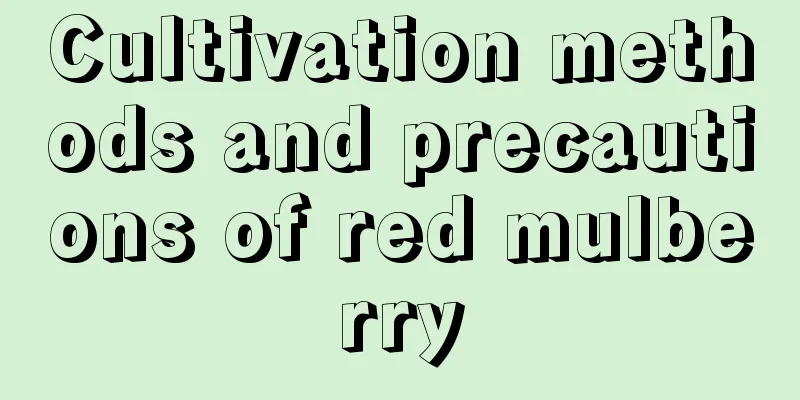Cultivation methods and precautions of red mulberry

1. Maintenance methods1. Soil: When planting red mulberry, it is best to mix garden soil and leaf mold. When the red mulberry is potted, a small amount of base fertilizer at the bottom can meet its growth needs. 2. Watering: It likes a humid growing environment. When caring for it during the growth period, it is best to keep the soil in the pot slightly moist. In summer, water it as much as possible because water evaporates more quickly. 3. Fertilization: Red mulberry has a relatively large demand for fertilizer. During its growth period, apply more nitrogen fertilizer to it, basically twice a month. Stop fertilizing after autumn because its growth rate gradually slows down. 4. Light: It will grow better in a warm environment and likes sunshine. When caring for it, try to let it receive sunlight as much as possible. It likes strong light, but still needs appropriate shade in summer. 2. Breeding techniques1. Reproduction: A more convenient way of reproduction is cutting propagation. In June-August, select new or two-year-old branches, insert them into the soil, and wait for them to sprout. 2. Pruning: In order to make the plant fuller, it is necessary to prune and top it during its growth period. This can stimulate the growth of more side branches. With more branches, the shape will be easier to maintain. 3. Problem diagnosis and treatment1. Root rot: In the early stage of root rot, the root system will rot, seriously affecting its absorption capacity, and will directly lead to death in the later stage. The cause of the disease should be checked from the soil. When the disease occurs, it is necessary to use carbendazim and carbendazim to irrigate the roots in time. 2. Leaf spot disease: It mainly manifests as brown circular spots on the leaves, which later spread to the whole plant, seriously affecting photosynthesis and appearance. Spray the leaves with 300 times diluted Trichoderma harzianum in time. IV. Other issues1. Can it be eaten: Red mulberry can be eaten. It has high nutritional value and contains many minerals and vitamins needed by the human body. It is known as the "longevity vegetable". 2. Can it be raised indoors: There is no problem in raising it indoors, but no matter what, the indoor conditions are definitely not as good as those outdoors. In addition, it is easier to be infected by bacteria if it is kept in a closed space for a long time with poor air circulation. It is better to raise it outdoors. |
<<: The cultivation methods and precautions of Albizia julibrissin
>>: Cultivation methods and precautions of monkey face flower
Recommend
What is the function of water chestnut
The ornamental function of water chestnut The lea...
Gongcai planting techniques, what does fresh Gongcai look like
1. Planting time When planting Gongcai, you can c...
How to grow durian
1. Seed germination After eating the durian pulp,...
Why is the crabapple flower considered unlucky?
1. The reason why it is considered unlucky (1) Fl...
Cultivation methods and precautions of azalea
1. Soil Rhododendrons prefer loose, fertile, slig...
The efficacy and function of lavender
Efficacy and function Ornamental value Featherlea...
What is the best fertilizer for green onions?
Fertilizing time for green onions Generally speak...
The efficacy and function of creeper
Its epidermis has lenticels. When summer comes, i...
Come and eat longevity vegetables in summer. They are everywhere on the roadside. Just pinch a branch and throw it in water and it will live!
Sweet potato leaves are a must-eat in summer to d...
How often should I water the Master? How long should I water him?
How often should the mage water the water? Spring...
Can green radish be watered with beer?
1. Can be poured You can water the green radish w...
How to root the goldfish spider plant in water (with illustrations of the cutting method)
1. Select branches There is no strict time limit ...
Complete method of propagating false epiphyllum
Cutting propagation of Epiphyllum pseudophthisis ...
How to water gardenia after repotting
Gardenia Watering Overview When watering gardenia...
Wintersweet pruning time and method
Wintersweet is a popular ornamental tree species ...









